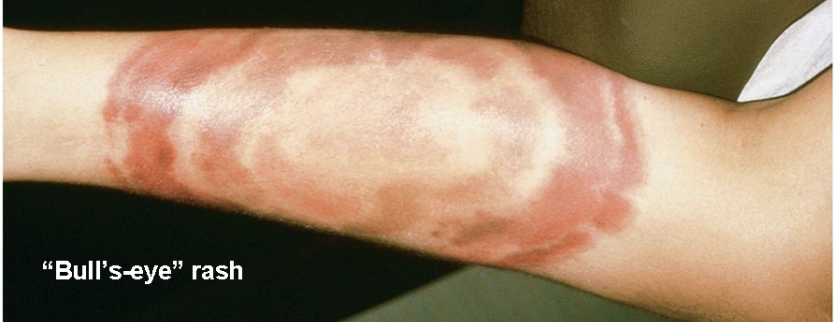microbio 2125 unit 5 (part 23) - Lyme Disease
1/14
There's no tags or description
Looks like no tags are added yet.
Name | Mastery | Learn | Test | Matching | Spaced |
|---|
No study sessions yet.
15 Terms
etiological agent
Borrelia burgdorferi
(& possibly Borrelia mayonii)
Distinguishing characteristics of etiological agent:
Large, gram-negative spirochete with 3–10 irregular coils
Transmitted by Ixodes ticks
Complex 2-year cycle involving mice (larvae infection) and deer (adult stage)
Virulence Factor(s):
Ability to persist and evade immune response
Causes slow, progressive infection mimicking autoimmune disorders
Predisposing Factors:
Outdoor activities in endemic areas (exposure to ticks)
Transmission:
Tick bite (Ixodes ticks) after feeding on infected small animals (e.g., white-footed mice)
Syndrome (signs + symptoms): Early symptoms:
Bull’s-eye rash (erythema migrans) in 50–70% of cases
Fever, headache, stiff neck, dizziness

Syndrome (signs + symptoms): Late symptoms (if untreated):
Cardiac and neurological symptoms
Polyarthritis
Affected body region/system:
Skin, nervous system, joints, cardiovascular system
Treatment:
Tetracycline or amoxicillin during active infection
Prevention:
Human vaccine discontinued
Protective clothing outdoors
Insect repellents with DEET
Other notes:
Nonfatal but slowly progressive if untreated
Early detection and treatment are critical to prevent serious complications
Other species of Borrelia have recently been shown to also cause Lyme disease in some cases
life cycle of lyme disease 1
Newly hatched larvae become infected when they feed on small animals such as mice, which harbor the spirochete. The larvae continue development through this year.
life cycle of lyme disease 2
In the second year the larvae molt into the nymph, an aggressive feeding stage.
life cycle of lyme disease 3
The nymph takes blood from a number of hosts, including deer and humans.
life cycle of lyme disease 4
On deer, the nymphs mature into adult male and female ticks, which mate. The female lays eggs in plant litter, where they hatch and once again begin the cycle.